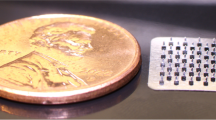Abstract
Purpose
Microneedles applied to the skin create micropores, allowing transdermal drug delivery of skin-impermeable compounds. The first human study with this technique demonstrated delivery of naltrexone (an opioid antagonist) for two to three days. Rapid micropore closure, however, blunts the delivery window. Application of diclofenac (an anti-inflammatory) allows seven days of naltrexone delivery in animals. The purpose of the current work was to demonstrate delivery of naltrexone for seven days following one microneedle treatment in humans.
Methods
Human subjects were treated with microneedles, diclofenac (or placebo), and naltrexone. Impedance measurements were used as a surrogate marker to measure micropore formation, and plasma naltrexone concentrations were measured for seven days post-microneedle application.
Results
Impedance dropped significantly from baseline to post-microneedle treatment, confirming micropore formation. Naltrexone was detected for seven days in Group 1 (diclofenac + naltrexone, n = 6), vs. 72 h in Group 2 (placebo + naltrexone, n = 2). At study completion, a significant difference in impedance was observed between intact and microneedle-treated skin in Group 1 (confirming the presence of micropores).
Conclusion
This is the first study demonstrating week-long drug delivery after one microneedle application, which would increase patient compliance and allow delivery of therapies for chronic diseases.



Similar content being viewed by others
Abbreviations
- COX:
-
Cyclooxygenase
- MN:
-
Microneedle
- NTX:
-
Naltrexone
- NTXol:
-
Naltrexol
- SC:
-
Stratum corneum
References
Prausnitz MR, Langer R. Transdermal drug delivery. Nat biotechnol. 2008;26(11):1261–8. PubMed PMID: 18997767. Pubmed Central PMCID: 2700785. [Journal article].
Arora A, Prausnitz MR, Mitragotri S. Micro-scale devices for transdermal drug delivery. Int J Pharm. 2008;364(2):227–36. PubMed PMID: 18805472. Pubmed Central PMCID: 2752650. [Journal article].
Paudel KS, Milewski M, Swadley CL, Brogden NK, Ghosh P, Stinchcomb AL. Challenges and opportunities in dermal/transdermal delivery. Ther Deliv. 2010;1(1):109–31. Journal article.
Prausnitz MR. Microneedles for transdermal drug delivery. Adv Drug Deliv Rev. 2004;56(5):581–7. PubMed PMID: 15019747. Epub 2004/03/17. eng. [Journal article].
Prausnitz MR, Mitragotri S, Langer R. Current status and future potential of transdermal drug delivery. Nat Rev Drug Discov. 2004;3(2):115–24. PubMed PMID: 15040576. Epub 2004/03/26. eng. [Journal article].
Kim YC, Park JH, Prausnitz MR. Microneedles for drug and vaccine delivery. Adv Drug Deliv Rev. 2012;64(14):1547–68. PubMed PMID: 22575858. Epub 2012/05/12. Eng. [Journal article].
Bal S, Kruithof AC, Liebl H, Tomerius M, Bouwstra J, Lademann J, et al. In vivo visualization of microneedle conduits in human skin using laser scanning microscopy. Laser Phys Lett. 2010;7(3):242–6. Journal article.
Banks SL, Paudel KS, Brogden NK, Loftin CD, Stinchcomb AL. Diclofenac enables prolonged delivery of naltrexone through microneedle-treated skin. Pharm Res. 2011;28(5):1211–9. PubMed PMID: 21301935. Pubmed Central PMCID: PMC3377386. Epub 2011/02/09. eng. [Journal article].
Banks SL, Pinninti RR, Gill HS, Paudel KS, Crooks PA, Brogden NK, et al. Transdermal delivery of naltrexol and skin permeability lifetime after microneedle treatment in hairless guinea pigs. J Pharm Sci. 2009;99(7):3072–80. PubMed PMID: 20166200. Pubmed Central PMCID: 2862091. Epub 2010/02/19. eng. [Journal article].
Gupta J, Gill HS, Andrews SN, Prausnitz MR. Kinetics of skin resealing after insertion of microneedles in human subjects. J Control Release. 2011 May 26. PubMed PMID: 21640148. Epub 2011/06/07. Eng. [Journal article].
Wermeling DP, Banks SL, Hudson DA, Gill HS, Gupta J, Prausnitz MR, et al. Microneedles permit transdermal delivery of a skin-impermeant medication to humans. Proc Natl Acad Sci. 2008;105(6):2058–63. PubMed PMID: 18250310. Pubmed Central PMCID: 2538880. [Journal article].
Brogden NK, Milewski M, Ghosh P, Hardi L, Crofford LJ, Stinchcomb AL. Diclofenac delays micropore closure following microneedle treatment in human subjects. J Control Release. 2012;163(2):220–9. Journal article.
Valiveti S, Nalluri BN, Hammell DC, Paudel KS, Stinchcomb AL. Development and validation of a liquid chromatography-mass spectrometry method for the quantitation of naltrexone and 6beta-naltrexol in guinea pig plasma. J Chromatogr B Anal Technol Biomed Life Sci. 2004;810(2):259–67. PubMed PMID: 15380723. Epub 2004/09/24. eng. [Journal article].
Darlenski R, Fluhr JW. Influence of skin type, race, sex, and anatomic location on epidermal barrier function. Clin Dermatol. 2012;30(3):269–73. PubMed PMID: 22507039. Epub 2012/04/18. eng. [Journal article].
Milewski M, Stinchcomb AL. Vehicle composition influence on the microneedle-enhanced transdermal flux of naltrexone hydrochloride. Pharm Res. 2011;28(1):124–34. PubMed PMID: 20577787. Epub 2010/06/26. eng. [Journal article].
Ghosh P, Pinninti RR, Hammell DC, Paudel KS, Stinchcomb AL. Development of a codrug approach for sustained delivery across microneedle treated skin. J Pharm Sci. Accepted for publication, January 2013.
Toebak MJ, de Rooij J, Moed H, Stoof TJ, von Blomberg BM, Bruynzeel DP, et al. Differential suppression of dendritic cell cytokine production by anti-inflammatory drugs. Br J Dermatol. 2008;158:225–33.
Acknowledgments and Disclosures
We would like to acknowledge Dr. Mark Prausnitz and Dr. Vladimir Zarnitsyn (Georgia Institute of Technology) for their expertise regarding the MNs and impedance measurements, and the staff at the UK Center for Clinical and Translational Science for their assistance. This work was funded by the following NIH grants: CTSA 1UL1RR033173-01, R01DA13425, R42DA32191, 1F31DA029374, and the Clinical Loan Repayment Program. Other funding included the UK Center for Clinical and Translational Science Seed Grant.
Dr. Stinchcomb is the Chief Scientific Officer of AllTranz Inc., a specialty pharmaceutical company involved in the development of transdermal formulations for microneedle delivery; both she and Dr. Banks are significant shareholders in the company.
Author information
Authors and Affiliations
Corresponding author
Rights and permissions
About this article
Cite this article
Brogden, N.K., Banks, S.L., Crofford, L.J. et al. Diclofenac Enables Unprecedented Week-Long Microneedle-Enhanced Delivery of a Skin Impermeable Medication in Humans. Pharm Res 30, 1947–1955 (2013). https://doi.org/10.1007/s11095-013-1036-1
Received:
Accepted:
Published:
Issue Date:
DOI: https://doi.org/10.1007/s11095-013-1036-1




